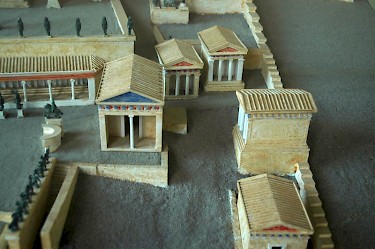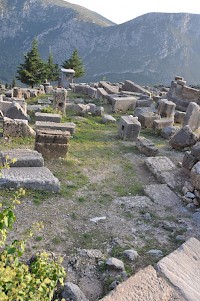Treasury of the Corinthians
Treasury of the Corinthians: small monument in Delphi containing the gifts to Apollo from (among others) the people from Corinth.

The grateful visitors of the Delphian oracle often left presents for the god. Originally, they were probably stored in the temple itself or directly in front of it, but later, the largest cities started to build treasuries: small buildings, the size of a freight container, where the gifts were stored. The tyrant Cypselus, ruler of Corinth in the third quarter of the seventh century BCE, was the first to build a treasury.
Because Corinth was a powerful city and because Cypselus was the first, he could chose the best site in the sacred enclosure: close to the entrance of the temple, on a site dominating the whole precinct, next to the Prytanaeum (the meeting place of the Delphian prytaneis or executive magistrates). It was an indication Cypselus' influence at the oracle.

The remains of the Corinthian treasury are not very remarkable, but it appears to have been one of the most splendid monuments in the Delphian sanctuary. The gifts on display were not just from Corinth, though: the Greek researcher Herodotus of Halicarnassus mentions several gifts from Anatolian kings. Midas of Phrygia sent "the royal seat whereon he sat to give judgment, and a marvelous seat it is".note The Mermnad kings of Lydia continued this practice. King Gyges sent silver objects and six golden bowls, which became proverbial.note Ingots of gold, bowl of silver and gold, and a lion of gold, sent by Croesus and originally in the temple itself, were placed in the Corinthian treasury after the big fire of 548 BCE.note
Writing in the Roman age, Pausanias says that "the Lydian gold used to lie here", using the past tense. It had been taken away by the Phocians to pay for mercenaries during the Third Sacred War (356-346 BCE). The victors, the people from Thebes, reused the place in the sanctuary to dedicate a statue to Heracles.note Pausanias also refers to bronze images, dedicated by the Phocians after they had defeated the Thessalian cavalry in an unknown battle.note
Other objects mentioned by Pausanias are a bronze statue of Zeus and a statue of Aegina, brought by the Phlasians; a bronze Apollo offered by the Mantineans; a group of Heracles and Apollo fighting over the Delphian tripod, offered by the Elians, and made by the sculptors Chionis, Diyllus, and Amyclaeus in the late sixth century BCE.note